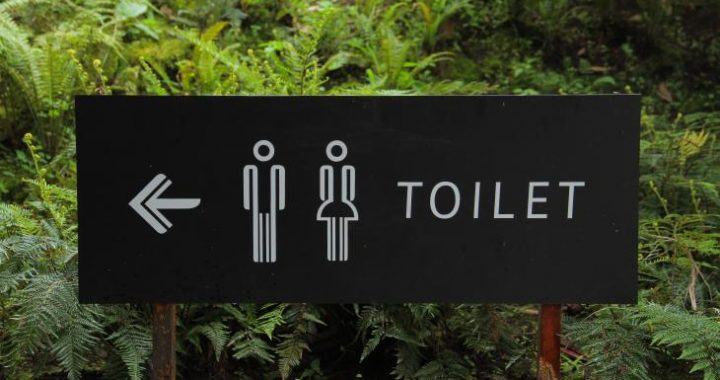On Nicola’s visit to the Edinburgh Fringe, she sat down with Elaine AKA Gusset Grippers to get the lowdown on pelvic health and incontinence during and after pregnancy. Check out the video highlights below. Full transcript available under the video.
Video Highlights
Transcript of full interview
N: I’m pregnant, and I need some help with my pelvic floors. So I was hoping you’d be able to give me some tips on how best to do my pelvic floor exercises well, and some things that I might expect after labour, some things that can go wrong with my pelvic floors and how I can fix them.
E: Good, well I’m glad you’re here! Well lots of people think its labour that’s the problem with pelvic floors, but it’s actually pregnancy itself because your pelvic floor’s supporting weight of everything. So as you become more pregnant then your pelvic floors are having to do more work. Some people think that if you have a caesarean you won’t have problems with your pelvic floors, but that’s not the case at all.
N: That’s really interesting, you assume that it’s the baby coming through and doing all of that damage that’s the issue.
E: It certainly doesn’t help, you’re three times more likely to have issues if you’ve had a vaginal birth than if you’ve had a C section, and certainly you’re at more risk for tears and episiotomies. But it’s the long slow weight that the PF is having to support in the pregnancy, and the pregnancy hormones that’s the problem that start to create a cascade of change. So that’s why it’s really important to teach women how to do their pelvic floors in their first pregnancy, and the NICE guidelines say that should be taught in your antenatal classes. In practice though there’s so much other information to get across in those classes that actually sometimes it’s really difficult to take that information on board. In my experience though, you’re not interested, you’re only really interested in how that baby is going to come out safely, and the rest gets put on your to do list for later, which unfortunately never comes. So it’s really important that women are focused on their pelvic floors during pregnancy, because a good strong pelvic floor actually reduces the length of the second stage of labour, the pushing stage. There’s a bit of a myth that your pelvic floor can be too tight, and can extend the length of the second stage, but it is just a myth.
N: OK so good strong pelvic floors = hopefully a better labour, right?
E: Yes, exactly. It’s certainly going to go in your favour, put it that way! You might as well become stronger. And as you become more pregnant, the position of the baby means that your bladder’s getting squashed so there’s less capacity, meaning women are needing to go to the toilet more often and they’re up in the night more. It would be normal for a woman to be up 2 or 3 times in the night, which is a clever way of preparing you for being up with a baby, I’m sure there’s a link there!
N: There must be! Yeah, well that’s already happening with me. Before I was pregnant it was rare for me to be up in the night needing a wee, but I definitely do now, at least once, sometimes twice. Before if I did wake up in the night, I could just hold it in and go back to sleep, but I definitely can’t do that anymore. Is that normal, or should I be able to still hold it in?
E: No, that’s definitely normal. If you’re up more than once in the night normally then we’d look on that as being a problem with capacity and you might need to have that looked at, but for now, you’re pregnant so you’ve got a free pass! I’ve got a little model to show you here. So in pregnant women the baby is sitting directly on top of the bladder, so that’s why you need to wee more frequently. It’s really common, not normal, but common, for women to leak a little in the last few weeks of pregnancy, but it’s really important for you to flag that up with your midwife because it could mean it will continue after labour. It’s been shown that women who wet themselves in the first 6 weeks after having baby, then that doubles the risk of postnatal depression.
N: That’s a huge number.
E: Yes, and if they do leak in the first six weeks after having a baby but don’t do anything about it, they’re likely to still be leaking when the baby’s twelve. So it doesn’t go away on it’s own.
N: That’s a really long time to be struggling with those issues.
E: Well women do, it takes an average of 7 years for a woman to come for help. Part of that is that women think it’s normal to leak after pregnancy, and it is common, but it’s not physiologically normal, you don’t need to put up with it.
N: You can fix it, great. So how do I fix it?
E: The action of your pelvic floor is to squeeze and lift, so the sphincters that go around the holes contract, which keeps them shut, and support the organs that sit above. So imagine you’re holding in a wee fart! But you’ve got to be able to breathe at the same time, because your pelvic floor moves up and down with your diaphragm, so if you hold your breath then it’s not going to work properly.l So don’t hold your breath, and the contraction is felt right underneath in the gusset of your pants, and you’re just lifting it up a wee small distance. It’s a difficult thing to imagine because you can’t see if you’re doing the exercises properly, so some people have done some work into it and they found that the best command that works is to imagine you’re holding in a fart.
N: Excellent, right. Holding in a fart. Got it!
E: So imagine you’re in a lift with your boss and your mother in law, and somebody you’ve got a big crush on, and your partner as well if you have to.. now you feel a big fart coming on, so you squeeze and lift for the count of 10. I’m doing it now, but you can’t tell because my face is just still.
N: Yeah, I have found that when I’ve tried it in the past my face goes all sorts of ways. It comes in my jaw like… I think I might need a bit more practice!
E: People usually get a really far away look in their eye like they’re having deep important thoughts, but just doing deep important things I suppose! So you need to do that for 10 seconds, which is important so that you’ve got good control so you can wait until you can go somewhere suitable to the toilet. One long slow hold for 10 seconds, then 10 quick flicks, which would be like ‘I need to fart!’ ‘oh no it’s gone away’ ‘That’s going to be horrible!’ ‘oh no, it’s gone away again’ and do ten in a row at that kind of pace, and do those three times a day. That’s what the science says.
N: I guess it’s easy to do those in the morning you know, when you get into the office, sit down at your desk and go through your emails, it’s easy enough to be sitting just doing it quickly right? Or when that lady in front of you is telling her life story to the cashier at the supermarket checkout and you’ve got some time to kill…
E: Absolutely, you can do them anywhere. And it doesn’t matter what you do them to, it just matters that you do them. I’ve been tweeting out clench along songs, you know anything that has a pun in them, something by Wet Wet Wet or Squeeze or something like that, and just telling people to do one clench per beat, because that’s better than nothing. So sitting in the car listening to the radio’s a really good one for your quick flicks. Then see if you can hold for a chorus, or a longer period of time.
N: So what if I can’t do the ten second hold? Am I alright just to do it shorter for now?
E: It will build up. Some women can only manage a flicker with their pelvic floor, but they can build it up. The reason we talk about the ten second hold is because there’s a reflex inhibition of the urge to pee so that funny dance thing you do, it will go away. If you can contract to ten, then the urge to pee will go away, so if you can’t make it to ten now, keep practicing and you will get there.
N: Just keep trying then?
E: Absolutely. What you’re looking for is that you can feel it relax, so sometimes people have got a really good contraction, but they can’t relax and can only manage for 3 seconds then it starts to fade off, and that’s OK, just aim then for 4 seconds. It takes 12 to 16 weeks, because it’s a really unusual muscle, it’s full of gristle, so it takes a little time for it to work. But it will get there.
N: And it’s totally worth it.
E: Well I think so. The secondary effects of incontinence have a massive impact on lives, particularly women’s lives when you have babies and young children to deal with, that if you’ve got toddlers that are sprinting off, then it makes you hesitate because you’re scared you’re going to wet yourself. Trying to get reluctant children into car seats and buggies can cause you to wee, even just pushing a buggy, and this can really affect how you feel about yourself in a way that no other things do. Issues of incontinence really do affect every single thing we do, you know, your sense of wellbeing is really tied up in continence issues. Plus, you know, it’s makes your orgasms better!
N: Excellent!
E: I think we need to make more of that to encourage people to comply, and there’s some suggestion that women can feel an improvement in their orgasms after just two weeks, so there’s a great motivator to keep going. Everybody needs a silver lining!
N: Mind you, if you’ve just had a baby, how many of us actually can be bothered to have sex? Like no, get away… then again, I guess it’s important to maintain that aspect of your relationship too, so if you’re gonna do it, then you may as well enjoy it! What about tools and things we can use to help us with our pelvic floors? I’ve heard about the Squeezy app, but I’ve heard about vaginal trainers but I don’t really know much about them, so why might I need those?
E: There’s lots available. I had a woman recently who came in with a suitcase with hundreds of pounds worth of equipment that she’d bought but never used! There isn’t necessarily any evidence that says a gadget is better than just doing the exercises, but the Squeezy app is evidence based and NHS endorsed, so if you were going to get anything, get the app. It reminds you to do them, but also talks you through how to do them, so it’s a useful thing to have. You can get electrical stimulators that are providing an electrical impulse to make the muscles contract. We use those in clinic, they do have a purpose, but they tend to be for women who have very little control at all, that can’t initiate a contraction. My concern with women buying those independently is that they don’t have a diagnosis, and the problem might actually be that their pelvic floor is too tight, and you don’t want to make the pelvic floor tighter so that can be quite dangerous. There’s other things that work on Bluetooth, they’re trainers that sit in your vagina and connects to your phone so you can track your progress and see how strong you are and if you’re doing it right.
N: That’s quite useful?
E: It is, and it’s also got a decelerator in it, so if you’re not doing it correctly it will tell you off and make you do it right. They are quite expensive, but this kind of equipment tends to be, but it is worth doing. There’s another thing called a Neem Educator which hasn’t got any electrical bells and whistles, it’s just a like a plastic tampon that has a stick on the bottom of it, so it goes into your vagina, and when you do your squeeze and lift if you’re doing it correctly it will tip down, but if you’re cheating and holding your breath or squeezing your bum cheeks it’ll tip up.
N: Oh that’s clever, it’s really simple.
E: It’s really simple, and they’re only about 7 quid to buy. So once you’ve got into the habit of doing your pelvic floors you’ll start to find them really easy, especially once you start to see a difference in your symptoms.
If you’re using vaginal trainers and dilators, always use a good, pH friendly, water-based lubricant like Sylk to keep you comfortable and get the most out of your treatment. Get your free sample today




